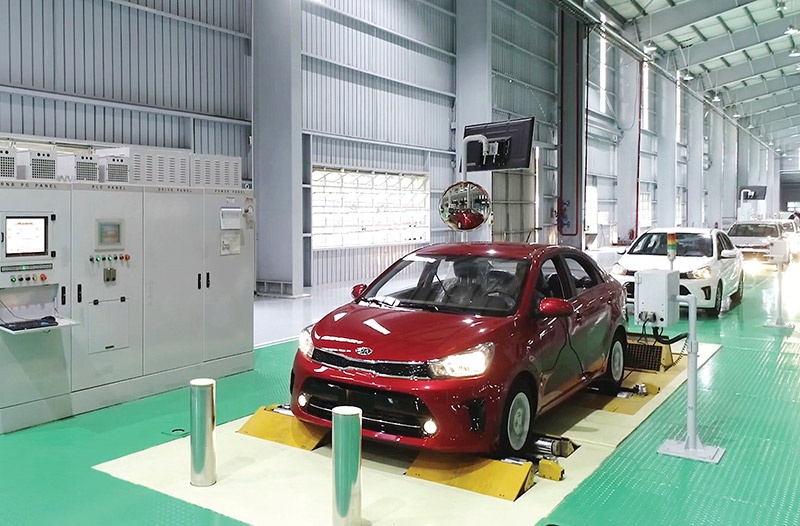Local suppliers miss out on expansions
 |
| Some sectors are dependent on imports, meaning local profits are not as vast as they could be, Le Toan |
Nguyen Duong Hieu, chairman of Lidovit in Ho Chi Minh City, recently made a trip to the southern province of Binh Duong to promote cooperation in the standardisation of screws for the wood processing industry. Each wooden product uses many different types of screws, leading to a large inventory when buyers change designs.
“Vietnam produces a lot of wooden furniture but does not have many types of shared components, which could create higher productivity and more competitive prices,” Hieu said.
Lidovit is leading the domestic screw market, but Hieu’s company still cannot compete with foreign enterprises in Vietnam, especially from Taiwan. “As long as we have to make many types of screws, manufacturers like us have to invest in many types of moulds, leading to higher prices and less competitiveness,” said Hieu.
Around 40 per cent of Lidovit’s revenue comes from the wood processing and export industry, while the company is also involved in the production of electrical equipment. Although Lidovit wants to expand, Hieu worries that his company would not be able to cover the market’s demand with the current resources.
Hurdles in domestic supply
According to the General Statistics Office, in Q1 of this year, Vietnam’s industrial production continue strongly recovering, with the whole sector’s added value increasing 7.07 per cent on-year – including an on-year rise of 7.79 per cent in manufacturing and processing.
Many foreign-invested enterprises (FIEs) have the need to find domestic suppliers in order to promote their projects. For instance, Bosch Vietnam is ready to accompany suppliers for several years to improve their capacity, said Nguyen Khac Anh Kiet, head of the Bosch Automotive Research & Development Centre.
However, Bosch’s search for domestic suppliers has so far not been successful. “No enterprise has met the requirements of Bosch in the past three years. Suppliers want to process orders immediately while most foreign enterprises require patience, investment in technology, and qualified human resources,” explained Kiet.
Supporting industries play a fundamental role in Vietnam’s processing and manufacturing sector. But in the past two years, Vietnam only had about 5-10 per cent of its enterprises producing mechanical components and plastic moulds, mainly in Hanoi and Ho Chi Minh City, as noted by the Vietnam Association for Supporting Industries.
Toyota announced on March 1 that its production plan had to be cut due to a lack of human resources. The delivery plan for its cars may still be affected in April and further delay deliveries into May, read the announcement. Toyota Vietnam has also been trying for years to increase localisation by calling for investment and helping to improve the capacity of domestic suppliers.
Currently, the carmaker has 46 suppliers, with the total number of localised products reaching over 720 of all kinds. But of the 46 suppliers, only six are from Vietnam, providing mechanical and plastic components.
Hiroyuki Ueda, general director of Toyota Vietnam, said the country’s supporting industries are difficult to develop due to low output.
“Vietnam has advantages in high-quality human resources and low labour costs, but local suppliers are limited in terms of experience and product management capacity, while raw materials must be imported because Vietnam has no sources for high-quality industrial materials yet,” said Ueda last year.
FIEs’ exports accounted for 73.6 per cent or $247.5 billion of Vietnam’s total export turnover in 2021. However, the figure does not reflect the supply for FIEs that depends heavily on imports as the local mechanical sector remains stuck.
Guidance required
Dao Phan Long, chairman of the Vietnam Association of Mechanical Industry, commented that the lack of policies to support and protect the domestic market has led to a narrowing of market share and a reduction in competitiveness. “Existing policies are not focused on supporting industries, leading to a low localisation rate and low value-added domestic parts,” Long said.
According to the Ministry of Industry and Trade’s report for 2016-2020, the mechanical industry only met around a third of the demand for parts and has almost no key industrial products. Although it is still far from the government’s market size of $300 billion, the number of mechanical enterprises is continuing to increase rapidly, showing the development potential of Vietnam’s mechanical sector.
What the stars mean:
★ Poor ★ ★ Promising ★★★ Good ★★★★ Very good ★★★★★ Exceptional
Related Contents
Latest News
More News
- PM sets January deadline for high-speed rail consultant (January 06, 2026 | 08:40)
- New decree spurs on PPP implementation (December 31, 2025 | 19:01)
- Global alliance develops $1 billion AI data centre network in Vietnam (December 30, 2025 | 10:08)
- Standing out in the Chinese outbound investment wave (December 29, 2025 | 10:29)
- Bright spots obvious in foreign investment mission (December 29, 2025 | 09:00)
- Ho Chi Minh City hits $8.37 billion in FDI (December 29, 2025 | 08:28)
- Vietnam and UK cooperation backs finance talent for IFCs (December 27, 2025 | 16:31)
- Global partnerships key to Vietnam’s IFC development (December 26, 2025 | 16:18)
- Vingroup pulls out of bid to invest in North-South high-speed railway (December 26, 2025 | 11:42)
- Strengthening supply chains through trade promotions and customs reform (December 24, 2025 | 14:00)

 Tag:
Tag:




















 Mobile Version
Mobile Version